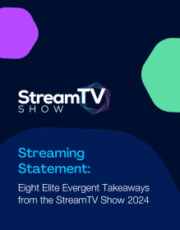Technology has changed the way customers interact with businesses. Nowhere is this more evident than when consumers make digital purchases through a browser or within an app. Modern consumers who pull out their credit cards based on what they see on screen expect a seamless customer experience that is not only frictionless but also highly tailored to their needs. Having a good product on its own doesn’t cut it anymore. By listening to what customers want, service providers that offer recurring subscriptions can retain customer loyalty and continue to bring in new customers.
This begs the question, what does this all mean for OTT streaming services? In an OTT environment, offering a seamless customer experience goes beyond providing a single-click check-out. It’s about building a relationship with customers and maintaining that relationship if a customer is already part of a subscription service. Service providers need to ensure that their user journey and experience feel effortless so that their customers are more likely to stay loyal to the platform.
Reducing Friction to Leave a Lasting Impression
In a recent survey on customer service, 89% of participants say that a company’s quick response plays an important role when deciding which companies to buy from. An overall smooth customer experience follows this. In OTT, quick response means reducing friction at every turn. Users should be able to get what they want with as few clicks or taps as possible. Take Amazon's one-click purchase, for example, where customers can complete a purchase by clicking on the "buy now" button the second they decide to buy something. With little to no friction, the buyer journey becomes seamless and instant and leaves a positive experience.
Even better than reducing friction is to remove it altogether. OTT providers are partnering with carriers as a customer acquisition strategy. The service providers bundle the OTT service with their core services as part of a “hard bundle,” so the moment they turn on their new device, they can seamlessly access and complete service authentication. To illustrate, T-Mobile differentiates its services by providing unlimited data family plan subscribers free access to Netflix through a hard bundle agreement. Agreements like this not only benefit customers but also allow service providers to grow their reach.
Meeting Customers on Their Terms
At Evergent, we believe in providing users with a seamless and delightful experience at every step of their OTT streaming journey. More than having little to no barrier for frictionless access, a good customer experience also follows through to the end, which means allowing grace periods for payment, or having the ability to inform customers when something is wrong with their payments.
Offering a variety of payment options is always a win-win when it comes to meeting customers on their terms and expanding your business reach. If unsure, use A/B testing to see what works for your users. Will registration before payment be a good way to go about it, or does it make more sense to offer payment options first, then register after?
Thanks to social media, today’s consumers are more likely to share their experiences, good or bad. A study by Citel Group reveals that 30% of consumers would share their bad experiences on social media. On the flip side, 49% said they would share their positive experiences on social media. This proves the importance of not only avoiding bad customer experience but to make an effort to ensure a good customer experience, as it may considerably affect long-term business for companies. By running appropriate A/B tests to understand users better, OTT services can meet the needs of their customers and perhaps even gain new customers along the way through positive word-of-mouth.
Give Customers the Freedom to Choose
Ultimately, OTT providers need to remember that customers want to be treated as people, not as numbers in a system. Companies need to know who their customers are to create marketing journeys that meet their needs. For example, they can offer smaller bundles to people who don’t frequently log in and larger bundles to those who use the services more heavily. It also helps to know what content the customer has consumed and suggest new options based on their interests.
Treating customers as people also means giving them the freedom to choose. The fact that Netflix doesn't "lock in" its customers plays a role in ensuring good customer retention, as users don't feel the burden of being tied to a service without a way out. Taking this one step further, the company recently announced that it would terminate inactive accounts for its customers to help them save money. At the end of the day, it's about demonstrating the human touch behind the technology by valuing customers' thoughts and preferences.
Conclusion
Technology and the high availability of OTT services have set the bar high when it comes to the way people consume media. With more and more options becoming available, OTT providers can no longer be complacent about customer service and must always strive to provide the best. They must go above and beyond to ensure that customers' expectations are met and, even better, exceeded. Next to having a good product with easy access, customer service has to be prioritized in the end-to-end user journey because it has the power to make or break a business. Just remember that if they don’t, someone else will.






